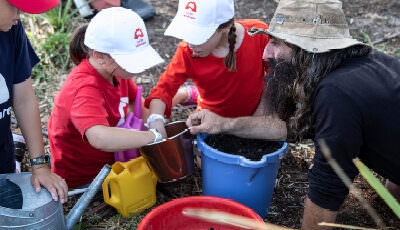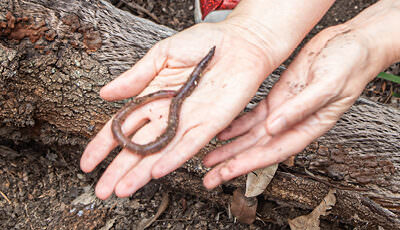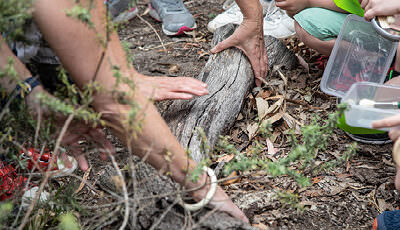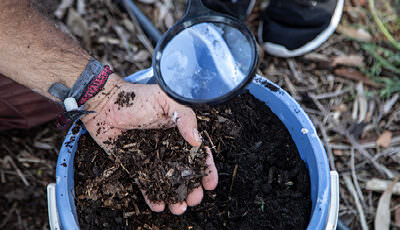
Investigating the soil food web
Time Allocation: 30-40 minutes*
Activity Level: Moderate
Introduction
In every square metre of soil, there are millions of organisms. These organisms make up the soil food web. The soil food web recycles nutrients in the soil, making them available for plant growth. The concept of the soil food web may be very new to children and educators alike. This activity is designed to facilitate a hands-on exploration of some soil samples to find evidence of the soil food web.
Preparation of equipment and resources prior to beginning the learning activity will help to make it a success. Access to magnifiers is helpful because some of the organisms are quite small. If magnifying glasses are not available, using technology such as the camera on phones and tablets can be a good substitute and there are a number of apps that allow these cameras to be used in macro mode.
*Time allocation is dependent on site selection and travel time.
Checklist
Instructions
 STEP 1
STEP 1
Identify a location for this investigation. Good locations to look for include under leaf litter, logs and in the mulch layer of the garden bed. Look for damp soil with plenty of organic material. (broken down leaf litter)
It is a good idea to collect a few samples first and set them aside to help with your explanation to the children later. Refer to the Educator’s Notes for some pointers on what to look for.
Assemble the materials you will need to conduct this investigation, including the digging/sampling tools and the resources you will need to view the soil samples.
We suggest establishing an area nearby your chosen location to use the magnification tools and complete the activity sheet.
 STEP 2
STEP 2
Before heading outside, discuss the idea of recycling. Focus on things that the children will be familiar with, such as recycling paper.
Explain that earth’s processes also recycle. Nutrients are recycled when organic material, such as leaves, bark and branches break-down.
A nutrient is a substance used by an organism to survive, grow, and reproduce.
In soil, nutrient recycling is performed underground by the soil food web. Take a moment to introduce the topic of the soil food web. Ask the children if they can describe what a worm does. Tell the children that the worm is part of the soil food web, but there are also other components too.
Use the soil food web diagram from the reference list below and show the children other elements of the food web and how they are linked together. (See the Educator’s Notes for more information).
Use online resources to research organisms that the children may encounter including:
- springtails
- nematodes
- the mycelial threads of fungi.
 STEP 3
STEP 3
Head outside to the area that you have set-up for your investigation.
Outline safety aspects to the children, when conducting their observations.
- instruct how to use the garden trowels, spoons, paddle sticks or paintbrushes
- guide the children to tread lightly, taking care not to stand on anything living while exploring
- ask the children to return things back to how they found them, e.g. turned rocks or logs.
Ask the children to engage their senses during the investigation and take note of how the soil smells and feels as they sort through the organic layer.
 STEP 4
STEP 4
Bring the samples to your investigation area.
Use the magnifiers or an app on a mobile phone or tablet to zoom-in on the samples.
Ask the children to explain what they see and what they wonder.
Use the activity sheet to draw what they see, and using the close-up inset circle to draw more detail as observed under magnification.
Return the samples back to where they were found.
Ask the children: what do they think we would find if we looked in the leaf litter again in:
- 3 days
- 3 weeks
- 3 months.
Extension Activity
Investigate the life-cycle of a springtail, drawing the stages of its life.
Become mycologists (fungi scientists) and grow your own mushrooms with a mushroom kit (these are commercially available).